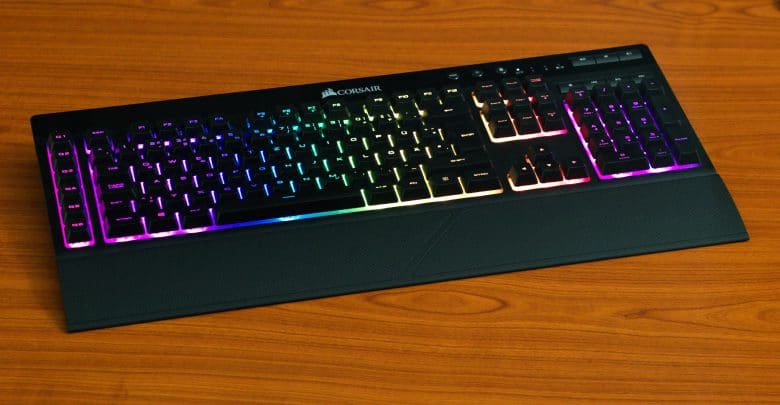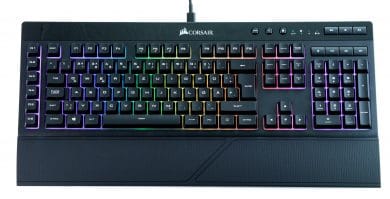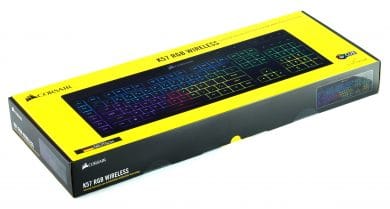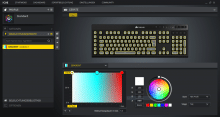
Corsair’s newly introduced K57 RGB Wireless is not only one of the company’s few wireless keyboards, but also one of the models that relies on rubber dome switches instead of mechanical buttons. The K57 is also the first keyboard to use the Capellix LEDs announced at CES.
These should be particularly small, but in comparison to normal LEDs – despite their smaller area – they should shine similarly brightly and also work more efficiently. The latter is particularly important for a wireless keyboard: Corsair promises an operating time of eight hours at maximum brightness. At the start of sales a price of about 100 Euro is targeted, currently the keyboard is available for € 132.34 * Euro. The following test will show how the model performs in practice and whether Corsair can keep its promises.
Design and Workmanship
The K57 RGB Wireless comes in a cardboard box with Corsair’s signature design. The accessories consist of a manual and warranty instructions, a USB cable without sheathing and an optional 6.5 cm deep wrist-rest.
In contrast to the Corsair K63 Wireless with mechanical buttons, the K57 RGB Wireless has a number pad. In addition to the familiar multimedia and three function keys, there is an additional row of macro keys located on the left side.
These also rely on rubber dome switches and are also illuminated by RGB LEDs. Instead of the cheaper backlighting often used for rubber domes, Corsair relies on the lighting approach of mechanical keyboards: Each key of the K57 RGB Wireless has its own LED. This results in a very uniform light image, only under the space bar a darkening can be seen.
While the majority of the keyboard is made of matt black plastic, the housing above the F series has a glossy black surface. On this surface are the manufacturer logo, the function keys and three of the multimedia keys as well as the status LEDs. Apart from this, the K57 RGB Wireless is largely unspectacular: single-stage folding feet, a simple plastic housing and a micro-USB connector on the back. In addition, there is also a holder for the included transmitter and a switch with which the keyboard can be switched on.
All in all, the workmanship of the K57 is decent, but nothing special. The case is robust, but could be a bit more stable. Moreover, some edges aren’t completely rounded. On the other hand, the material of the keycaps, which offers a pleasant feel, is well implemented. However, the use of high-gloss elements should not only find friends, as there are hardly any surfaces whose appearance is so quickly affected by dust, fingerprints and scratches. In addition, we would have liked the palm rest on the underside to be closed – instead you can see the inner structure.
Keys and Features
As mentioned at the beginning, the K57 RGB Wireless is one of Corsair’s few keyboards that doesn’t rely on mechanical buttons, but on rubber domes. According to Corsair, these should have a tactile printing behavior and withstand 20 million operations.
In addition, the company promises an 8-key rollover. Unfortunately, this is not always functional: several keys can always be pressed, but not eight in every combination. This should not lead to problems in normal use, but compared to other keyboards, which usually offer an N-key rollover, it is still a shortcoming.
The rubber domes used by Corsair are also positive. Of course, the implementation can’t be compared to the very defined writing feel of most mechanical keyboards, but the built-in buttons are quite pleasant – the company has made an effort here. Hardcore fans of mechanical keyboards will probably not be happy here, but in principle a change is possible very quickly and the K57 RGB Wireless is not significantly inferior to a mechanical keyboard in terms of writing feel.
This is also due to the aforementioned tactility, as this is less spongy than with many cheap rubber domes. With the K57 RGB Wireless, longer texts can be written without any problems and without being disturbed by the typing sensation. It should be kept in mind that the requirements here are individually different.
One advantage of the built-in keys, however, is clear: as usual, the built-in rubber domes are significantly quieter than mechanical buttons, making the keyboard well suited for frequent typists who don’t want to bother their fellow human beings with their keyboard. In this respect, the K57 does justice to the claim of being a “living room keyboard”. Thanks to the complete layout and the additional keys on the left and top, the K57 RGB Wireless is anything but small. Without the palm rest, it measures 48 x 16.5 x 3.4 cm and weighs 937 grams.
Software
The iCUE software used by Corsair is used as the control program. However, controlling the keyboard is not as easy as usual, as there are some special features. Only if the keyboard is connected by cable, it offers the full range of functions.
In wireless mode, there are still many lighting effects to choose from, but there are no options for creating your own effects or synchronizing with other RGB products. Moreover, Corsair apparently only gave the keyboard a small memory, as it can only remember the six macro keys (up to 50 characters) in combination with the lighting effect set on the device. But if you set something in the software, it only works if it runs in the background.
If this is the case, Corsair’s iCUE also delivers the familiar image on the K57 RGB Wireless: The program offers numerous lighting effects that can be adjusted in detail in cable mode. In addition, all keys can be reassigned and macros with virtually unlimited length restrictions can be recorded. This means that the keyboard is usually above average on the software side.
Practice
The K57 RGB Wireless performs well in practical testing. Corsair promises a response time of less than a millisecond, which is to be achieved using the new “slipstream” technology. We can’t measure this, but we can confirm that there is no significant latency compared to wired keyboards. In addition, the range is impressive: typing in the next room or even on another floor is possible without any problems. There are also two Bluetooth connection channels available as an option, which are supposed to consume a little less power than Slipstream.
The battery life of the keyboard is also praiseworthy: Corsair promises a battery life of eight hours for the “worst” case – with activated lighting at the highest brightness level. In the practical test in this same scenario, however, we came up with well over ten hours and thus enough time to survive a usual lanparty day. With weaker lighting, the battery life should increase significantly, without activated LEDs even 175 hours.
Writing and playing with the keyboard is also very pleasant over a longer period of time and doesn’t lead to any signs of fatigue. Only the surface of the wrist-rest is worth mentioning, as it is not suitable for every taste due to its rough structure.
Fulness
The K57 RGB Wireless is in many respects a specialty. A wireless keyboard with RGB lighting is as rare as a Corsair model without mechanical keys. With this combination, the K57 is unique in some respects and also the cheapest wireless keyboard currently available with the corresponding features.
The purchase recommendation for the K57 RGB Wireless also depends exactly on this special tuning: Does one have a purpose for a keyboard that manages without a cable, but is above average in size and offers correspondingly many additional keys? If so, this model is a good choice. The built-in rubber domes offer a very pleasant pressure point, the battery life is praiseworthy and the software is extensive as usual.
However, we would have wished for a little more stability for the case and the inclusion of profiles, but in view of the moderate selling price in combination with the special tuning of the device, it is possible to overlook this. All in all, it’s easy to say: If you like the basic concept of the K57 RGB Wireless, you definitely don’t make a mistake with the purchase.
Corsair K57 RGB Wireless
Workmanship
Features
Ergonomics
Software
Value for Money
Those who like the concept will also like the K57.
















